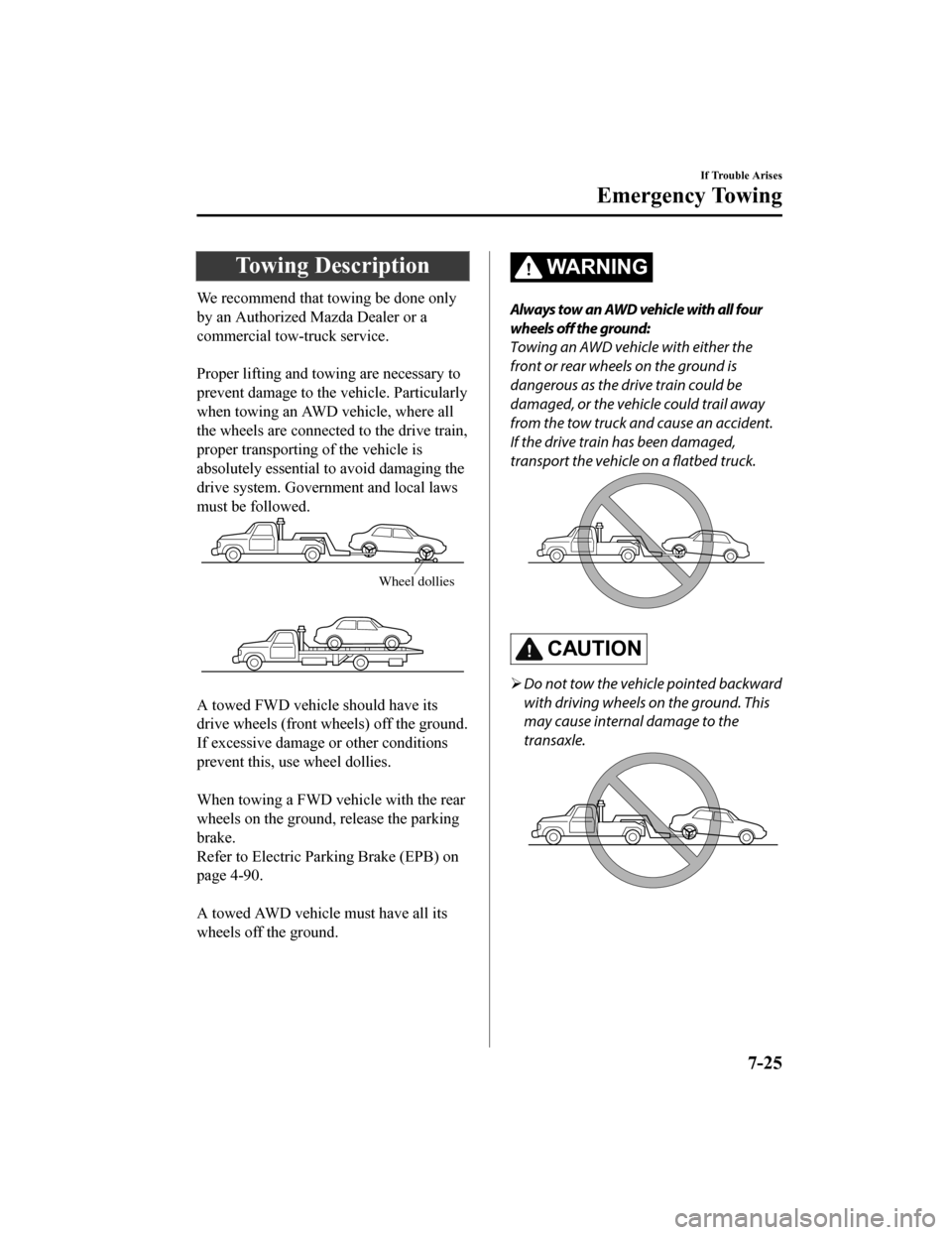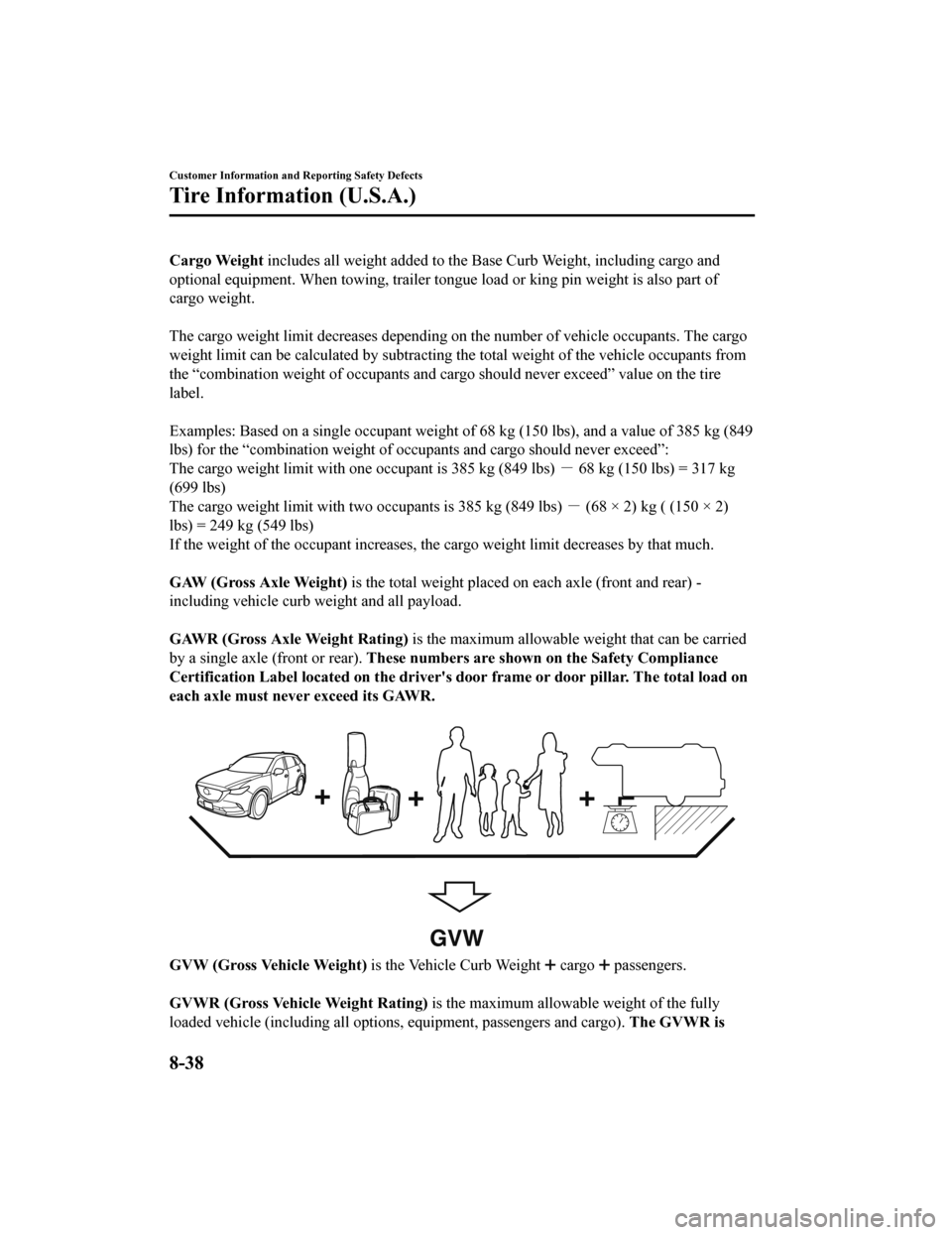towing MAZDA MODEL CX-9 2020 (in English) Owner's Manual
[x] Cancel search | Manufacturer: MAZDA, Model Year: 2020, Model line: MODEL CX-9, Model: MAZDA MODEL CX-9 2020Pages: 706
Page 579 of 706

Spare Tire and Tool Storage
Spare tire and tools are stored in the locations illustrated in the diagram.
Lug wrenchJack lever
Towing eyelet
Flat tire belt
Spare tire hold-down bolt
Jack
Tool bag
With sub-woofer
Lug wrenchJack lever
Towing eyelet
Flat tire belt
Spare tire hold-down bolt
Jack
Tool bag
Without sub-wooferSpare tire
Some models. Spare tire
▼
Jack
To remove the jack
1. Set the third-row seatbacks to their
on-road positions.
If Trouble Arises
Flat Tire
7-3
CX-9_8HT8-EA-19I_Edition2_old 2019-9-24 13:14:55
Page 598 of 706

Starting a Flooded Engine
If the engine fails to start, it may be
flooded (excessive fuel in the engine).
Follow this procedure:
1. If the engine does not start within 5seconds on the first try, wait 10
seconds and try again.
2. Make sure the parking brake is on.
3. Depress the accelerator all the way and hold it there.
4. Depress the brake pedal, then press the push button start. If the engine starts,
release the accelerator immediately
because the engine will suddenly rev
up.
5. If the engine fails to start, crank it without depressing the accelerator.
If the engine still does not start using the
previous procedure, have your vehicle
inspected by an Authorized Mazda Dealer.
Push-Starting
Do not push-start your Mazda.
WA R N I N G
Never tow a vehicle to start it:
Towing a vehicle to start it is dangerous.
The vehicle being towed could surge
forward when its engine starts, causing the
2 vehicles to collide. The occupants could
be injured.
NOTE
You cannot start a vehicle with an
automatic transaxle by pushing it.
If Trouble Arises
Emergency Starting
7-22
CX-9_8HT8-EA-19I_Edition2_old 2019-9-24 13:14:55
Page 601 of 706

Towing Description
We recommend that towing be done only
by an Authorized Mazda Dealer or a
commercial tow-truck service.
Proper lifting and towing are necessary to
prevent damage to the vehicle. Particularly
when towing an AWD vehicle, where all
the wheels are connected to the drive train,
proper transporting of the vehicle is
absolutely essential to avoid damaging the
drive system. Government and local laws
must be followed.
Wheel dollies
A towed FWD vehicle should have its
drive wheels (front wheels) off the ground.
If excessive damage or other conditions
prevent this, use wheel dollies.
When towing a FWD vehicle with the rear
wheels on the ground, release the parking
brake.
Refer to Electric Parking Brake (EPB) on
page 4-90.
A towed AWD vehicle must have all its
wheels off the ground.
WA R N I N G
Always tow an AWD vehicle with all four
wheels off the ground:
Towing an AWD vehicle with either the
front or rear wheels on the ground is
dangerous as the drive train could be
damaged, or the vehicle could trail away
from the tow truck and cause an accident.
If the drive train has been damaged,
transport the vehicle on a flatbed truck.
CAUTION
Do not tow the vehicle pointed backward
with driving wheels on the ground. This
may cause internal damage to the
transaxle.
If Trouble Arises
Emergency Towing
7-25
CX-9_8HT8-EA-19I_Edition2_old 2019-9-24 13:14:55
Page 602 of 706

Do not tow with sling-type equipment.
This could damage your vehicle. Use
wheel-lift or
flatbed equipment.
If the parking brake cannot be released
when towing the vehicle, transport the
vehicle with all front and rear wheels
raised off the ground as shown in the
figure. If the vehicle is towed without
raising the wheels off the ground, the
brake system could be damaged.
Wheel dollies
Towing Hooks (Mexico)
CAUTION
The towing eyelet should be used in an
emergency (to get the vehicle out of a
ditch or a snow bank, for example).
When using the towing eyelets, always
pull the cable or chain in a straight
direction with respect to the eyelet. Never
apply a sideways force.
NOTE
When towing with chain or cable, wrap
the chain or cable with a soft cloth near
the bumper to prevent damage to the
bumper.
▼ To w i n g H o o k s
1. Remove the towing eyelet and the lug
wrench from the luggage compartment
(page 7-3).
2. Wrap a flathead screwdriver or similar
tool with a soft cloth to prevent
damage to a painted bumper, and open
the cap located on the front or rear
bumper.
Front
If Trouble Arises
Emergency Towing
7-26
CX-9_8HT8-EA-19I_Edition2_old 2019-9-24 13:14:55
Page 603 of 706

Rear
CAUTION
Do not use excessive force as it may
damage the cap or scratch the painted
bumper surface.
NOTE
Remove the cap completely and store it
so as not to lose it.
3. Securely install the towing eyelet using
the lug wrench.
Front
Lug wrench
Towing eyelet
Rear
Lug wrench
Towing eyelet
4. Hook the towing rope to the towing eyelet.
CAUTION
If the towing eyelet is not securely
tightened, it may loosen or
disengage from the bumper when
towing the vehicle. Make sure that
the towing eyelet is securely
tightened to the bumper.
Be careful not to damage the towing
eyelet and towing hook, vehicle body,
or transaxle system when towing
under the following conditions:
Do not tow a vehicle heavier than
yours.
Do not suddenly accelerate your
vehicle as it will apply a severe
shock to the towing eyelet and
towing hook or rope.
Do not attach any rope other than
to the towing eyelet and towing
hook.
If Trouble Arises
Emergency Towing
7-27
CX-9_8HT8-EA-19I_Edition2_old 2019-9-24 13:14:55
Page 668 of 706

Cargo Weight includes all weight added to the Base Curb Weight, including cargo and
optional equipment. When towing, trailer tongue load or king pin weight is also part of
cargo weight.
The cargo weight limit decreases depending on the number of vehicle occupants. The cargo
weight limit can be calculated by subtracting the total weight of the vehicle occupants from
the “combination weight of occupants and cargo should never exceed” value on the tire
label.
Examples: Based on a single occupant weight of 68 kg (150 lbs), and a value of 385 kg (849
lbs) for the “combination weight of occupants and cargo should never exceed”:
The cargo weight limit with one occupant is 385 kg (849 lbs) - 68 kg (150 lbs) = 317 kg
(699 lbs)
The cargo weight limit with two occupants is 385 kg (849 lbs) - (68 × 2) kg ( (150 × 2)
lbs) = 249 kg (549 lbs)
If the weight of the occupant increases, the cargo weight limit decreases by that much.
GAW (Gross Axle Weight) is the total weight placed on each axle (front and rear) -
including vehicle curb weight and all payload.
GAWR (Gross Axle Weight Rating) is the maximum allowable weight that can be carried
by a single axle (front or rear). These numbers are shown on the Safety Compliance
Certification Label locate d on the driver's door frame or door pillar. Th e total load on
each axle must never exceed its GAWR.
GVW
GVW (Gross Vehicle Weight) is the Vehicle Curb Weight cargo passengers.
GVWR (Gross Vehicle Weight Rating) is the maximum allowable weight of the fully
loaded vehicle (including all options, equipment, passengers and cargo). The GVWR is
Customer Information and Reporting Safety Defects
Tire Information (U.S.A.)
8-38
CX-9_8HT8-EA-19I_Edition2_old 2019-9-24 13:14:55
Page 670 of 706

GCW (Gross Combination Weight) is the weight of the loaded vehicle (GVW) plus the
weight of the fully loaded trailer.
GCWR (Gross Combination Weight Rating) is the maximum allowable weight of the
vehicle and the loaded trailer - including al l cargo and passengers - that the vehicle can
handle without risking damage. (Important: The towing vehicle's braking system is rated for
operation at GVWR, not at GCWR. Separate f unctional brakes should be used for safe
control of towed vehicles and for trailers weighing more than 1,500 lbs). The GCW must
never exceed the GCWR.
Maximum Loaded Trailer Weight is the highest possible weight of a fully loaded trailer
the vehicle can tow. It assumes a vehicle with only mandatory options, no cargo (internal or
external), a tongue load of 10 -15% (conventional trailer) or king pin weight of 15-25%
(fifth-wheel trailer), and driver only (150 lbs). Consult your dealership (or the RV and
Trailer Towing Guide provided by your de alership) for more detailed information.
Tongue Load or Fifth-Wheel King Pin Weight refers to the amount of the weight that a
trailer pushes down on a trailer hitch.
Examples: For a 5000 lb conventional trailer, multiply 5000 by 0.10 and 0.15 to obtain a
proper tongue load range of 500 to 750 lbs. For an 11,500 lb fifth-wheel trailer, multiply by
0.15 and 0.25 to obtain a proper king pin load range of 1,725 to 2,875 lbs.
WA R N I N G
Never Exceed GVWR or GAWR Specifications:
Exceeding the GVWR or the GAWR specified on the certification label is dangerous. Exceeding
any vehicle rating limitation could result in a serious accident, injury, or damage to the
vehicle.
Do not use replacement tires with lower load carrying capacities than the originals because
they may lower the vehicle's GVWR and GAWR limitations. Replacement tires with a higher
limit than the originals do not increase the GVWR and GAWR limitations.
Never exceed the GVWR or the GAWR specified on the certification label.
Customer Information and Reporting Safety Defects
Tire Information (U.S.A.)
8-40
CX-9_8HT8-EA-19I_Edition2_old 2019-9-24 13:14:55
Page 671 of 706

Steps for Determining the Correct Load Limit
Steps for Determining Correct Load Limit-
(1) Locate the statement “The combined weight of occupants and cargo should never exceed XXX kg or XXX lbs.” on your vehicle's placard.
(2) Determine the combined weight of the driver and passengers that will be riding in your
vehicle.
(3) Subtract the combined weight of the driver and passengers from XXX kg or XXX lbs.
(4) The resulting figure equals the available amount of cargo and luggage load capacity. For example, if the “XXX” amount equals 1400 lbs. and there will be five 150 lb passengers
in your vehicle, the amount of available cargo and luggage load capacity is 650 lbs.
(1400 - 750 (5 × 150) = 650 lbs.)
(5) Determine the combined weight of luggage and cargo being loaded on the vehicle. That
weight may not safely exceed the available cargo and luggage load capacity calculated
in Step 4.
(6) If your vehicle will be towing a trailer, load from your trailer will be transferred to your
vehicle. Consult this manual to determine how this reduces the available cargo and
luggage load capacity of your vehicle.
Customer Information and Reporting Safety Defects
Tire Information (U.S.A.)
8-41
CX-9_8HT8-EA-19I_Edition2_old 2019-9-24 13:14:55
Page 699 of 706

Index
Pad wear indicator....................... 4-92
Warning light............................... 4-92
Break-In Period.......... ....................... 3-49
C
Capacities............................................ 9-4
Carbon Monoxide............................. 3-31
Cell Phones....................................... 8-20
Center Console................................ 5-104
Child Restraint Categories of child-restraint
systems.........................................2-49
Child-restraint precautions.......... 2-44
Child-restraint system
installation................................... 2-49
Child-restraint system suitability for
various seat positions table..........2-51
Installing child-restraint
systems.........................................2-55
ISOFIX child-restraint systems
(Mexico)...................................... 2-64
LATCH child-restraint systems
(Except Mexico).......................... 2-64
Child Safety Locks for Rear Doors... 3-20
Climate Control System...................... 5-4 Front Air Conditioner....................5-7
Gas specifications.......................... 9-6
Operating tips................................ 5-4
Rear Air Conditioner. .................. 5-13
Vent Operation (Front).................. 5-5
Vent operation (Rear).................. 5-11
Collision warning.............................. 7-51
Coming Home Light......................... 4-71
Cruise Control................................. 4-212 Cruise control switch.................4-212
Cruise main indication (white)/cruise
set indication (green)................. 4-213
Cup Holder...................................... 5-102
Customer Assistance. .......................... 8-2
D
Daytime Running Lights................... 4-72
Defogger
Mirror...........................................4-79
Rear window........... .................... 4-78
Dimensions.......................................... 9-5
Display.............................................. 4-12
Distance Recognition Support System
(DRSS)............................................ 4-133 Indication on display................. 4-133
Door Locks........................................3-12
Drive Selection................................4-109
Driving In Flooded Ar ea...................3-54
Driving on Uneven Road.................. 3-55
Driving Tips
Automatic transaxle.....................4-67
Break-in period............................ 3-49
Driving in flooded area............... 3-54
Driving on uneven road...............3-55
Floor mat..................................... 3-51
Hazardous driving.. ..................... 3-50
Overloading............. .................... 3-54
Rocking the vehicle. .................... 3-51
Saving fuel and protection of the
environment................................. 3-49
Turbocharged vehicles.................3-56
Winter driving............................. 3-52
Dynamic Stability Control (DSC)... 4-102 TCS/DSC indicator light........... 4-102
E
Electric parking brake (EPB)............ 4-90
Electric Parking Brake (EPB) Warning
Beep...................................................7-49
Emergency Starting
Push-starting................................ 7-22
Starting a flooded engine............ 7-22
Emergency Towing Towing description...................... 7-25
10-3
CX-9_8HT8-EA-19I_Edition2_old 2019-9-24 13:14:55
Page 700 of 706

Index
Towing hooks.............................. 7-26
Emission Control System..................3-30
Ending Screen Display....................4-107
Engine Coolant.........................................6-24
Engine compartment overview.... 6-21
Exhaust gas.................................. 3-31
Hood release............. ................... 6-19
Oil................................................ 6-22
Starting...........................................4-6
Essential Information.......................... 6-2
Event Data Recorder......................... 8-21
Exhaust Gas...................................... 3-31
Exterior Care..................................... 6-56 Aluminum wheel maintenance.... 6-60
Bright-metal maintenance........... 6-60
Maintaining the finish................. 6-57
Plastic part maintenance.............. 6-61
F
FlasherHazard warning........................... 4-80
Headlights.................................... 4-68
Flat Tire............................................... 7-3 Mounting the spare tire............... 7-13
Removing a flat tire...................... 7-9
Floor Mat.......................................... 3-51
Fluid Brake............................................6-25
Washer......................................... 6-26
Fluids Classification................................. 9-4
Fog Lights......................................... 4-73
Foot Brake.........................................4-89
Forward Sensing Camera (FSC)..... 4-201
Front Seat............................................ 2-5
Fuel Filler lid and cap......................... 3-32
Requirements............................... 3-29
Tank capacity.................................9-4
Fuel Consumption Display............. 4-106
Fuel Economy Monitor. .................. 4-106
Ending screen display............... 4-107
Fuel consumption display..........4-106
Fuses.................................................. 6-50 Panel description......................... 6-52
Replacement................................ 6-50
G
Gauges............................................... 4-12
Glove Compartment... ..................... 5-104
H
Hazardous Driving............................ 3-50
Hazard Warning Flasher....................4-80
Headlights
Coming home light......................4-71
Control......................................... 4-68
Headlight flashing....................... 4-71
High-low beam............................ 4-71
Leaving home light..................... 4-71
Leveling....................................... 4-72
Head Restraint................................... 2-28
High Beam Control System
(HBC).............................................. 4-118 High Beam Control System (HBC)
indicator light (green)................ 4-119
Hill Launch Assist (H LA)................ 4-97
HomeLink Wireless Control System
(Type A)............................................ 4-81
HomeLink Wireless Control System
(Type B)............................................ 4-84
Hood Release............. ....................... 6-19
Horn...................................................4-80
I
If a Warning Light Turns On or
Flashes............................................... 7-28
If the Active Driving Display Does Not
Operate.............................................. 7-53
10-4
CX-9_8HT8-EA-19I_Edition2_old 2019-9-24 13:14:55